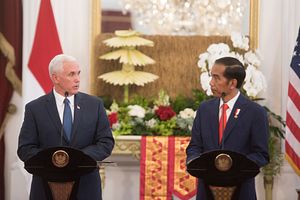U.S. Vice President Mike Pence has just concluded his visit to Indonesia — the world’s fourth largest nation, third largest democracy, and largest Muslim-majority country. It is the third leg of his four-nation swing through key U.S. allies and partners in the region.
Last week, I previewed the importance of Pence’s visit, the first of any cabinet official in Donald Trump’s administration to Southeast Asia. In my piece, I argued that the visit was not just an opportunity for Washington to kick off its engagement with a key emerging power and to signal its commitment to Southeast Asia more broadly, but also the beginning of a longer-term challenge in managing a key partnership that risks coming under strain (See: “Trump’s Indonesia Challenge Begins With Pence Visit”).
What did Pence’s visit actually accomplish this week?
Pence’s visit consisted of a variety of engagements, including a meeting with Jokowi at the presidential palace, a visit to Istiqlal Mosque, the largest mosque in Southeast Asia, a trip to the Secretariat of the Association of Southeast Asian Nations (ASEAN), which is located in Jakarta, and a roundtable session with business executives.
Pence said that the chief objective of his visit was to signal “the high value” that the United States places on its strategic partnership with Indonesia, forged during the Obama administration (See: “The New US-Indonesia Strategic Partnership After Jokowi’s Visit”). During Pence’s meeting with Jokowi and their joint news conference, both addressed several key issues that Washington and Jakarta are cooperating on within that partnership, such as terrorism and maritime security.
But Pence also used the visit as an opportunity to send other, more specific supporting messages as well. Given the rocky start that Trump has had with the Muslim world with the initial travel ban, Pence’s trip provided an opening to repair some of the damage that had been done in this area since he was going to be in the world’s largest Muslim-majority country. As expected, Pence used his visit to praise moderate Islam in Indonesia, calling it “an inspiration to the world.”
Yet as I indicated before the trip, it was not exactly the best timing for that message, considering the fact that Jokowi’s political ally Ahok had been dealt a defeat by Islamic conservatives at the Jakarta gubernatorial election, which some read as undermining Indonesia’s image as a moderate, tolerant nation (See: “The Trouble with Indonesia’s Ahok Test”).
Pence also used his trip to signal the administration’s commitment to Southeast Asia by announcing that Trump would in fact attend the East Asia Summit (EAS) in the Philippines and the Asia-Pacific Economic Cooperation (APEC) Summit in Vietnam, ending months of speculation (See: “Why Trump Should Go to APEC and EAS in Vietnam and the Philippines”). Though officials had been indicating that Trump would eventually commit to attend, making the official announcement in Indonesia –which has traditionally been seen as a leader within ASEAN and Southeast Asia – and after meeting ASEAN officials, carried a significance of its own (See: “Trump’s Real ASEAN Test”).
Pence also met with members of the Young Southeast Asian Leaders Initiative (YSEALI), one of the signature initiatives within the people-to-people dimension of U.S.-Southeast Asia relations under the Obama administration. “The future of Southeast Asia looks bright thanks to great programs like YSEALI that help prepare future business and civic leaders,” Pence said in a statement released later by the White House.
The visit was also a chance to get more clarity about the economic dimension of the U.S.-Indonesia relationship. Though this component of ties has traditionally lagged behind the others, Indonesia’s inclusion in Trump’s trade hit list of 16 countries with trade surpluses with the United States had raised the level of uncertainty.
In Jakarta, Pence indicated that there may need to be some reworking of the economic relationship so that it is free and fair. But both he and Jokowi stated that they were willing to work together to reduce barriers to trade and investments in a way that makes sense for both sides. Pence also communicated this to a roundtable discussion with business executives.
And in a sign of greater opportunities within the U.S.-Indonesia economic relationship, Pence on Friday witnessed the signing of 11 agreements worth more than $10 billion involving U.S. companies in Indonesia, including Exxon Mobil, Lockheed Martin, and General Electric.

































